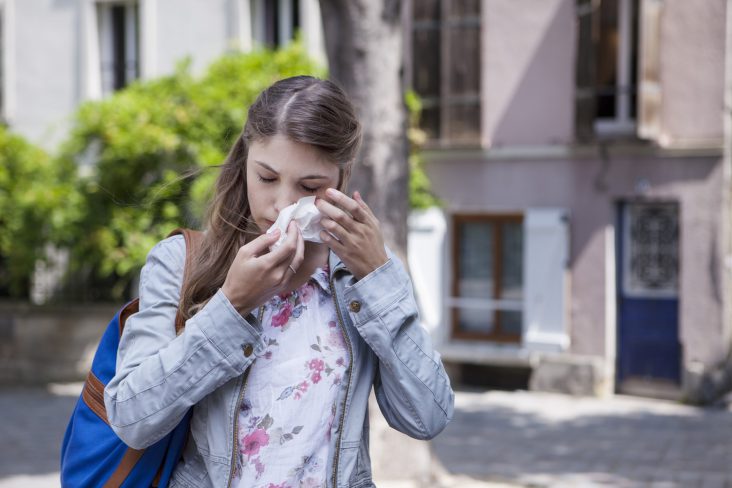Whether it is you, your spouse, or your kids who are suffering from it, conjunctivitis—better known as pink eye—can be an icky little inconvenience. It’s icky because the symptoms are, well, sometimes watery and crusty. But pink eye’s only a little inconvenience because people who contract it usually feel all better within about two to three weeks tops.
But what is pink eye? Are there multiple forms? How do you know if you have it and how do you treat it?
In this article, we will define pink eye, discuss its symptoms and treatments, and introduce preventative measures. By the end of it, you will be prepared if you encounter this community menace.
SYMPTOMS & SIGNS
It’s not that hard to tell if you or someone else has contracted pink eye. Thankfully, the virus reveals itself with a few telltale indicators in one or both eyes, so you won’t miss the signs. Be on the lookout (no pun intended) for the following symptoms:
- Redness (in or around the eyes)
- Watering/Crying
- Itchy Eyes
- Swelling
- Pus-like discharge
- Goopy crust (usually found in the morning)
These symptoms can cause anything from mild discomfort to severe irritation. Experiencing these symptoms is a strong indication of the development of pink eye and the immediate need for medical treatment.
WHAT EXACTLY IS PINK EYE?
Conjunctivitis—also known as pink eye—is really just an inflammation or infection of the conjunctiva, which is tissue on your eyelids and the whites of your eyes.
Although almost any form conjunctivitis only lasts about two to three weeks, during this period, the carrier is highly contagious. Though pink eye can be contracted through a number of different channels, there are only about three major kinds: bacterial conjunctivitis, viral conjunctivitis, and allergic conjunctivitis.
SPECIFIC TYPES
And even though there are about three major kinds, pink eye is still just pink eye. Many of the symptoms overlap and the experiences of each form of pink eye are very similar. But it’s best to fully understand what kind you or your loved ones are dealing with.
- Bacterial Conjunctivitis
- The majority of pink eye cases are caused by a bacterial infection. Its most common symptoms are swelling, redness, and pus-like, yellow discharge. Usually it appears in one eye first, but sometimes travels to both eyes. There can even be significant matting that makes the eyelashes stick together.
- Allergic Conjunctivitis
- Allergic pink eye, as the name suggests, is caused by allergens. This appears in people who have histories of seasonal allergies or in people who have irritation when pollen counts are elevated. But in addition to pollen, substances like smoke, dust mites, and perfume can also cause this sort of allergic pink eye. Those with allergic pink eye may also experience symptoms including watering/crying, swelling, redness, and itchiness. The eye will have clear drainage, and, like bacterial pink eye, there can be some matting in the morning making the eyelashes stick together.
- Viral Conjunctivitis
- This is caused by one of several different infections—sometimes it can even result from a sore throat or a common cold. Frequently the symptoms of viral pink eye are clear discharge, extreme itchiness, and redness. Typically, one eye will be red but it can easily spread to both eyes.
TREATMENT
Doctors may advise any number of treatments, but these are usually intended to relieve symptoms. Moreover, doctors’ recommendations depend on the type of pink eye contracted.
For example, concerning allergic pink eye, an eye doctor may prescribe specific things like antihistamines or mast cell inhibitors to reduce the possibility of both an allergic reaction and inflammation. On the other hand, when it comes to bacterial pink eye, doctors may prescribe antibiotic eye drops. It can depend on various factors.
Most of the time though, for allergenic, viral, and bacterial pinkeye, doctors recommend the following simple treatment methods:
- Applying artificial tears
- This serves as a tremendous relief from discomfort
- Cleaning your eyelids with a wet washcloth
- This removes the gunk and crust residue that accumulates
- Applying cold or warm compresses
- This will often relieve itchiness and swelling in the eyes
- Throwing away your contact lenses
- If you wear contact lenses that can be thrown away, do so immediately after recognizing the signs of pink eye
- Disinfecting non-disposable contact lenses
- This ensures that you don’t start the whole pink eye experience over again (it happens)
It should go without saying, but just as a reminder: since pink eye is contagious, those who exhibit symptoms should not leave their homes except to receive medical care.
But can you be proactive about pink eye? Absolutely.
TAKING PREVENTATIVE MEASURES
In most cases, pink eye can be debilitating and a little gross. It’s best to do what’s possible to prevent it. So be on the safe side, and practice good hygiene. Take the following steps to prevent the contraction of pink eye:
- Wash your hands as often as possible
- Think of all of the rails, door knobs, and counters we touch on a daily basis
- Do not touch your eyes
- Your hands carry about 5,000 germs—each; don’t put them in your eye
- Use your own clean towels and washcloths daily
- Sharing these items is a big risk, so be selfish, and don’t share your towels
- Wash your pillowcases as frequently as possible
- Don’t let your pillowcases get dirty
- Keep eye cosmetics and personal eye care items to yourself
- Sharing these items can risk an eye infection
- Don’t collect eye makeup and personal eye care items
- After you use it, throw out that petri dish.
YOU ARE NOT ALONE
Pink eye can be a miserable experience. It’s gross, a little ugly even, but it doesn’t last forever. What’s more, since most people end up experiencing it at one time or another in their lives, you’re not alone.
So don’t panic if you contract pink eye, aka Conjunctivitis. If the symptoms don’t resolve within 24 hours or less, just schedule an appointment with us. We’ll be happy to help you through it.

